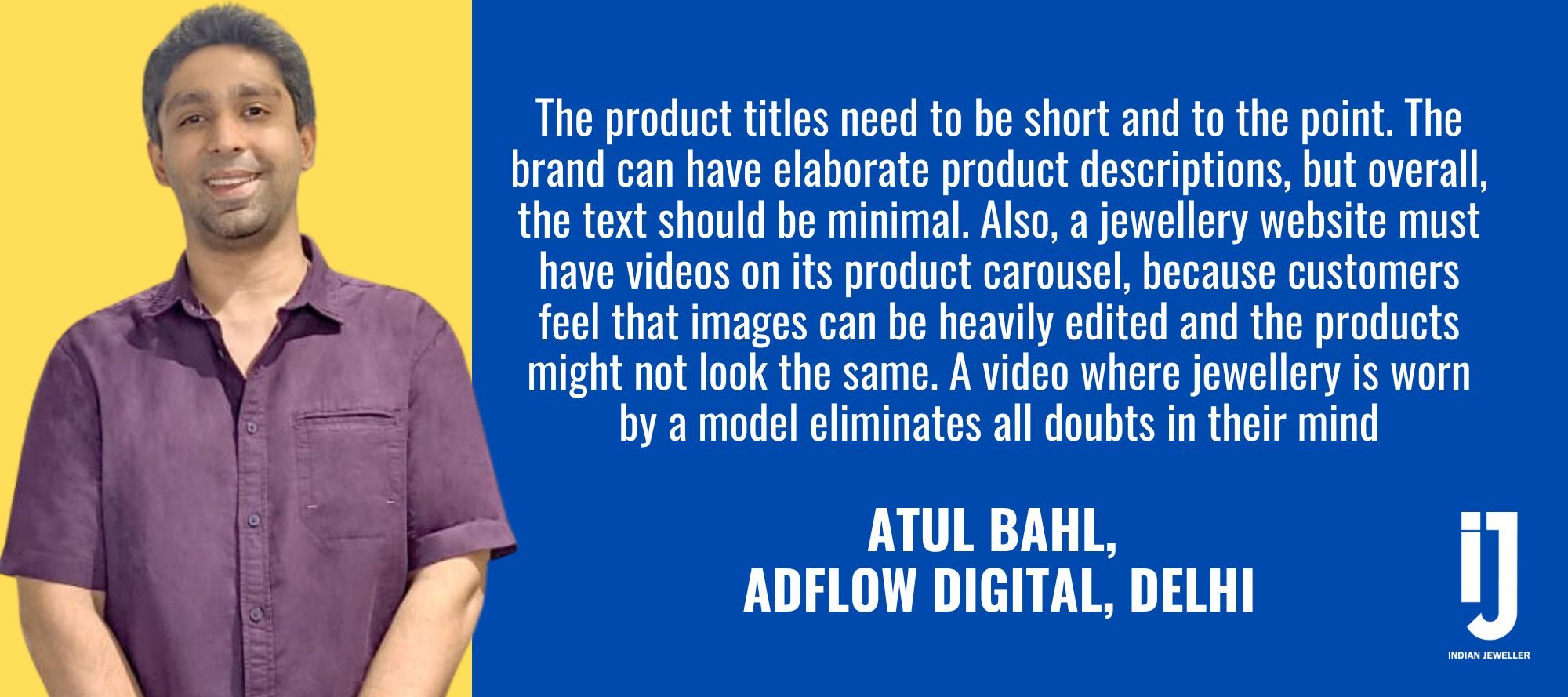A well-planned website is essential for any jewellery brand looking to stay competitive and relevant. To create the optimal site, it is important to strike the right balance between high-quality visuals, informative content, and a consistent tone that accurately reflects the brand's identity, says Priyanka Talreja Garegrat

A well-designed website can help attract customers, showcase the range of products, and, ultimately, increase sales. Here are 10 tips for creating the perfect website for a jewellery business.
1. Deciding the Hosting Platform for the Website
The platform you choose for your website should meet your business needs and align with your brand's goals and budget. Atul Bahl, Adflow Digital, Delhi, says, “According to me, the two major CMS platforms today are Shopify and Magento. In the previous year, the evolution of these two platforms has led many users to steer away from WordPress, as it has now become comparatively slow.”
With each of these platforms comes a major hosting fee, which companies should be aware of. Pallavi Nopany, Pallavi Nopany Studio, Bangalore, says, “It is crucial to understand the platform the website will be hosted on, and be aware of the cost implications. This is because the platform may charge a recurring percentage of sales, which should be taken into consideration before creating the site.” Thus, factors like hosting fees, transaction fees, and the add-on features being offered should be noted.

2. Speaking Via Images
As jewellery is a visual product, customers rely heavily on images to evaluate its quality, design, and overall appeal. Jewellery brands have to not only attract buyers, but also build trust. This amplifies the need for high-quality images which are shot professionally. Napony says, “Visuals are everything to any e-commerce website. Images coming from one brand should have the same tone and offer a sense of aesthetic so that they can be recognized. Images shot on the phone are also fine, but each capture should have a great deal of thought behind it, and should reflect imagination.”
3. Keeping the Text Minimal
For a jewellery website, it is important to keep the text minimal and let the images speak for themselves. Says Bahl, “The product titles need to be short and to the point. The brand can have elaborate product descriptions, but overall, the text should be minimal, so that the product imagery and the collection pages are clear and attractive.”
At the same time, today’s modern websites require content that is optimised for search engines. Therefore, one should leverage textual schema that makes the most of important details of the product. For instance, the weight of the jewellery piece in grams, the caratage, the certification details, etc, should be mentioned.
4. Showcasing Products Effectively
This is a parameter that will change with each site, as each brand has a different vibe. Nopany says, “While some people like to display their products in a catalogue style on a white background, others like it to be imaginative, with campaign-based photography, where they are selling a lifestyle and not just the product.”
Moving on from images, Bahl believes that the jewellery website must have videos on its product carousel. “This is because customers feel that images can be heavily edited and the products might not look the same. A video where jewellery is worn by a model eliminates all doubts in their mind,” he adds.
5. Having a Comprehensive Homepage
Like a catalogue in the jewellery store, a homepage should reflect a glimpse of all that the brand has to offer. “Rather than offering individual pieces, let the homepage be a place where people can easily jump to what they are looking for. Use the homepage to feature multiple collections, bestsellers, under Rs 10k products, newly launched on Instagram collections, and so on. On product pages and collection pages, you can talk about each product in detail,” says Nopany.

6. Recreating Your Physical Store Online
Typically, most jewellery purchases are intimate experiences that have a build-up to the final purchase. While there’s still some time before technology allows us to recreate that electronically, the huge leaps in tech innovation have enabled newer online experiences. “Using the strength of online technology to recreate things like movement, animation, interaction, sound, and good-quality images, allows us to create an experience that is highly engaging for online customers and makes them come back to the website again and again,” says Nopany.
7. Focusing on the Menu Architecture
Heatmaps, click-through rates, page flows, and drop-offs are important indicators of user behaviour as potential customers journey their way across a website. Planning out the digital journey well in advance comes with a lot of benefits, as one can then merge the organic flow of users and plot newer launches, related items, and trending pieces at strategic points to drive higher conversions.
“Figure out what products customers are looking for. Are they looking for earrings? Have they come looking for a collection that was launched on Instagram? Or are they looking for items with the price or material as the criteria? Have these categories singled out and listed, so people can find what they came for,” says Nopany. According to Bahl, “The navigation has to be based on product types, as that is what users are looking for. Basing them on collections is not the best idea, as collections are more of a benefit for the brand itself.”
8. Making the Website Mobile-friendly
With the cheapest data plans, the highest smartphone penetration, and the youngest population, India is one of the most mobile-savvy markets globally. Any brand that is looking at a digital presence and targeting retail consumers has to have a robust mobile strategy. “The first impression comes from the mobile. In my experience, 90% of the traffic is driven to the site via the mobile, ensuring that the site is optimised for mobile-first. I would suggest having a team that understands UI/UX so the site can be customised for the brand, rather than fitting the site into a ready-made template. I would also suggest that the brands shoot all images vertically to fit the mobile screen, as the horizontal layout is not that important anymore,” says Nopany.
9. Creating a Website Is Not a One-time Activity
While creating a website is a daunting task, and many companies heave a sigh of relief once it is done, it is important to understand that a website is like an ever-changing organism. It is essential to keep updating the content. That includes refreshing any imagery that has been on the website for long periods. Within such content, one should specifically focus on collection thumbnails. "Often, a collection image goes up as a thumbnail and it gets stuck. Then for years, customers see the same thumbnail. It feels very dated. Try and ensure that you do something very creative for collection thumbnails, or ensure that the thumbnails are all up-to-date,” says Nopany.
10. Checking Under the Hood
Just as the content on the website gets dated, so does the technology that powers the site. Technology moves at a fast pace and newer updates and security patches are constantly created for the back-end, the front-end, the databases, etc. Search engines are known to reward updated sites and penalise obsolete ones. By not updating your website architecture, you can lose out on precious organic traffic and the resulting business. Says Nopany, “Don’t keep the site stuck to a collection. Keep it as modular as possible so that you can change it around and have something new going up every week. That way, the site will always be current."
Be the first to comment